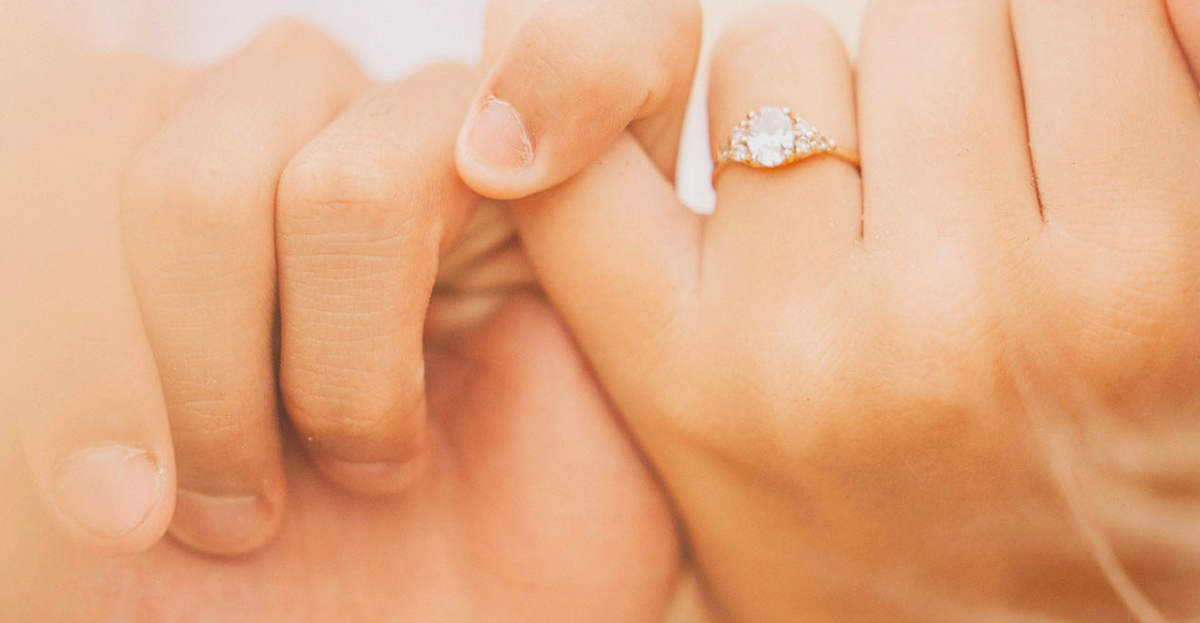What comes to mind when you think about “The One”? Beauty, curves, class? We’re talking about the engagement ring, of course, but these are actually very legitimate criteria when searching for the perfect ring!
Choosing an engagement ring for your future fiancée is indeed all about the details. From shape, to colour to style… it will match her personality and taste and be an item she is proud to wear on her finger every day for the rest of her life (no pressure!).
Read our guide for all the help you need when picking THE engagement ring.
Engagement ring myths
Once upon a time, men were expected to spend the equivalent of three months’ wages on an engagement ring. Over time, however, opinions have changed on this matter.
There are no hard and fast rules about how much one should spend on a ring – some might spend less, some more.
Lots of brides prefer the idea of a vintage piece or family heirloom than an expensive ring. Some also like to be involved in designing or choosing a ring, instead of having a proposal sprung on them. Let’s face it, some women would rather take charge and propose to their man before he gets around to it, so you see the ring and how it is presented really is down to personal choice.
However, if you have traditional values and feel confident that you can wow your loved one with the ring of her dreams, then we are excited to guide you on this journey. So, let’s get started!
Where to start?
The good news is that you have already made up your mind that you want to spend the rest of your life with your partner, so the chances are that you know her quite well. Think about her style and personality and the type of jewellery she wears on a regular basis to get an idea of her likes and dislikes.
If you are feeling uncertain and she hasn’t dropped any hints as yet, then it might be wise to ask her family or friends what kind of ring they think she would like.
Engagement ring shapes
Engagement rings come in a variety of shapes, which probably doesn’t make this decision any easier for you!
The most common type of engagement ring is a solitaire, i.e. a single stone set in a metal or paved band. However, there are so many considerations even with this option – the choice of stone, its shape, if it has a shoulder design, whether it has a halo (also known as ‘cushion cut’), if it sits flat or is high set…
It’s also good to ask about a matching engagement and wedding ring set to ensure the two sit nicely together.
For something a little more unique, there are some lovely vintage-inspired designs such as flower shapes, as well as Art Deco rings with complex geometric designs.
Diamonds and precious stones
It is common to choose diamonds for an engagement ring, due to their beautiful and timeless appearance. But there are many more precious and semi-precious stones to choose from too.
Choosing a diamond can be quite overwhelming. The term ‘cut’ refers to the shape of the diamond (round, oval, marquise, heart, emerald, princess, pear). Know also that ‘cut’ can refer to the way it has been cut into shape and how this affects its appearance. This is where clarity comes in.
Diamonds are graded for quality and clarity on a cut scale, with the very best making the overall price of the ring more expensive. To the untrained eye, a lower grade cut may look dark, small or possibly even cloudy and lacking in sparkle.
Finally, you may have come across the term ‘carat’ when looking at jewellery. Carat is the unit of measurement used to weigh diamonds. So the higher the carat, the bigger the stone.
Choosing a metal
Choosing the right metal is just as important as finding the right stone. You want to pick a tone that you are used to seeing your partner wearing. For instance, if she wears cool-toned jewellery then you might like to consider white gold or platinum which are more durable than sterling silver. Whilst platinum is a natural white metal and often the more expensive option, white gold is an alloy made up of gold, nickel and zinc.
For reference, if a ring was stamped as 18 karat (the unit for measuring the proportion of gold in an alloy) then it would comprise 75% pure gold.
If she prefers a warmer tone, then you have the option of yellow gold or rose gold.
Further options and advice
While most rings can be resized if necessary, it’s useful to know what size your partner’s ring finger is before you buy the ring. This can be found out by using an existing ring as reference. Imagine the disappointment if she can’t show off the ring straight after the proposal!
Even though it’s easy to fall in love with “The One”, it’s always a good idea to look around and compare rings so that you can be sure that you are choosing the best and most cost-effective option. After all, you want to save as much as possible knowing you have a wedding to plan!
Ring certificates are also a great way to guarantee the authenticity of your purchase, and this will help it to keep some of its value over the years.
Finally, try to enjoy the process of choosing the ring and presenting it during that very special proposal. Remember that you know your bride better than anyone so if you think she will love it then she is bound to be over the moon!
Happy shopping!
